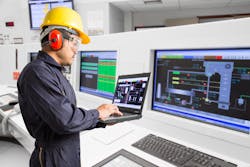Mastering PID control: applications, tuning and limitations explained
Proportional-integral-derivative (PID) control stands as a fundamental technique in the field of controls engineering. It plays a crucial role in regulating systems and maintaining desired outputs.
For both engineers and technicians, it’s crucial to comprehend PID control operation and practical applications. The three components of PID control—proportional, integral and derivative—work together to achieve stability, accuracy and responsiveness in various systems.
Whether it's in temperature regulation, robotics or industrial automation, grasping the concept of PID control empowers factory personnel to optimize performance and enhance efficiency.
The PID control algorithm is widely used in manufacturing processes. The proportional, integral and derivative components of the control loop are present. The output of the proportional component is inversely correlated to the difference in precision between the desired and actual values. To get rid of steady-state errors, the integral component integrates the error over time. The derivative component predicts future errors based on the rate of change of the error. By combining these components, PID control achieves a balance between responsiveness, stability and accuracy, ensuring efficient control of various systems.
Proportional control (P): The proportional control component of PID control plays a crucial role in adjusting the system's output based on the error between the desired setpoint and the actual process variable. The output is directly proportional to this error, with a gain factor determining the magnitude of the response.
The gain, or proportional gain, influences the system's sensitivity to error. A higher gain results in a more aggressive response, reducing the error faster but increasing the risk of overshooting and instability. Conversely, a lower gain leads to a more conservative response, providing stability but potentially slower error correction. Balancing the gain is essential to achieving optimal performance in the control system.
Integral control (I): The integral control component in a PID system is essential for eliminating steady-state errors. It addresses the accumulated error over time by continuously integrating the error and generating an output proportional to this accumulated error. By doing so, it effectively eliminates any persistent deviation between the desired setpoint and the actual process variable. However, it is crucial to carefully tune the integral gain to maintain system stability.
A higher integral gain can lead to faster error correction but may also introduce overshooting and instability. Conversely, a lower integral gain provides stability but may result in slower error correction. Striking the right balance is key to achieving optimal system response.
Derivative control (D): The derivative control element of a PID system, which responds to the rate of change of the error signal, is crucial. It computes the rate of change of the mistake and generates an output that counteracts unforeseen changes in the process variable. This increases the responsiveness and stability of the system. However, derivative control can also increase the system's noise, which might lead to instability and irrational behavior.
By reducing noise and guaranteeing a smooth response, filtering techniques can be utilized to solve this issue. The derivative gain needs to be carefully set to strike a compromise between noise reduction and system performance.
Practical applications
PID control finds widespread use in various industries due to its versatility and effectiveness. Speed control in motors, such as those used in robotics and industrial machinery, relies on PID control to maintain consistent and accurate speeds. In HVAC systems, PID control is employed for precise temperature regulation, ensuring optimal comfort and energy efficiency. In chemical processes, PID control plays a vital role in maintaining desired levels of liquid or gas, preventing overflows or shortages. These examples illustrate how PID control is instrumental in achieving stability, accuracy and control in diverse industrial applications.
Tuning and optimization of controllers
Proper tuning of PID controllers is important for achieving optimal performance in control systems. Various methods can be employed, including manual tuning, the Ziegler-Nichols method and advanced optimization techniques. Manual tuning involves adjusting the PID parameters based on system behavior, while the Ziegler-Nichols method provides a systematic approach to tuning. Advanced optimization techniques utilize algorithms to automatically find optimal PID parameters. Practical tips for tuning include starting with conservative gains, considering system dynamics and iteratively fine-tuning until the desired performance is achieved, resulting in stable and efficient control.
Limitations and extensions
Despite being widely utilized, PID control has certain drawbacks. It might not be appropriate for extremely complicated or nonlinear systems. To boost performance, robustness and adaptability to changing situations, PID control may be augmented or enhanced by utilizing other control systems, such as model-based control, adaptive control and fuzzy logic control. To get beyond the constraints of conventional PID control and offer more sophisticated control strategies, these systems employ extra intelligence and algorithms.
About the Author
Shawn Cox
Contributing Editor
Shawn Cox is a licensed master electrician/PLC programmer. He was co-owner/operator of Bobby Cox Electric for 15 years and is currently employed by BMW Manufacturing as an ESA. Contact him at [email protected].

Leaders relevant to this article:

